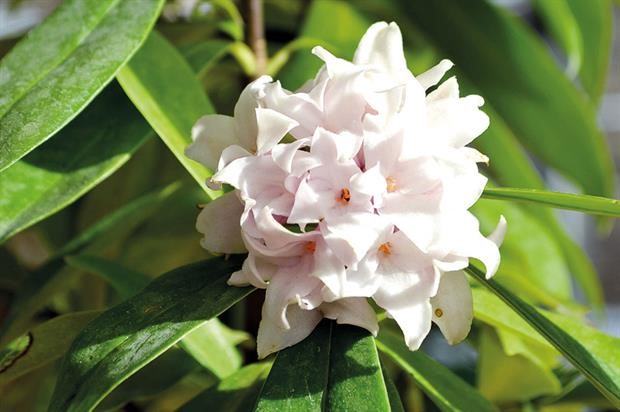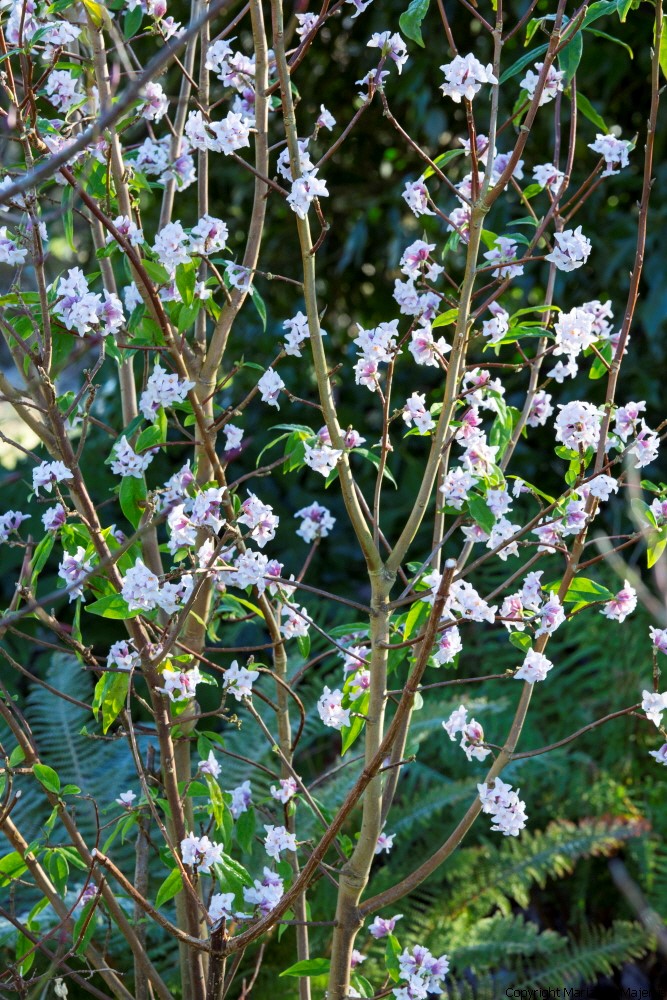
I apologise if you’re a Daphne, but Daphnes are capricious creatures. However I’m not talking people, I’m talking plants. These gloriously scented, shrubby plants, designed for hedonsists as well as gardeners, cast a special sort of magic and they’re an essential part of my garden. However, just when they’re at their best, they’re likely to turn up their toes and die. Sometimes it’s a lingering, slow death that starts with one leafy curling up. At other times their decline can be very rapid and there’s no cure so I always plant more daphnes on a regular basis.
If that self-destruct tendency is not bad enough. They’re difficult to raise. It’s easy enough to take cuttings from firm young growth in July and August and they do root. BUT, once potted up, they can be extremely difficult to persuade into growth and this puts nurseryman off so fewer and fewer commercial nurseries bother, If you find a good Daphne in a garden centre (or nursery ) snap it up because they’re always in short supply.
There’s always an exception that proves the rule and one of them, Daphne odora ‘Aureomarginata’, is easy peasy and this should be your starter for ten. In most years this sweetly fragrant Daphne flowers in March and April, although this February’s precocious warmth saw the buds open in January. It makes a low growing, wide shrub so you need about one and a half square metres of space. Mine is down by the gate close to other fragrant shrubs and it’s now thirteen years old. Is this an omen I ask myself?
‘Aureomarginata’ has green leaves edhed in mayonnaise yellow. It’s close to other fragrant beauties including Sarcococca confusa ( Sweet Box), Lonicera x purpusii ‘Winter Beauty’ and Chimonanthus praecox ( wintersweet). This combination ensures that between January and late March I (and any of my visitors) get a fragrant waft of sweet perfume as a welcome. Later Viburnum x burkwoodii takes over, a heady lily scent that could smother a small garden in fragrance. It’s another easy-peasy plant and not all viburnums are easy!
Further back in the border I have three columnar Daphnes capable of flowering in January, because Daphne flowers are rugged. They consist of thick sepals, rather than flimsy petals, and these rugged flowers can last up to six weeks, which makes them good garden value. Berries sometimes follow on some daphnes, but these are toxic, just like the rest of the plant.
Daphne bholua ‘Jacqueline Postill’ always flowers in January, because it’s a selected evergreen form of a Himalayan species used to cool condition. Various ones are around and they can be deciduous, or semi-evergreen of fully evergreen. In the cool, tree-shrouded Himalayas cold air slips down the well-drained slopes, but soggy British winters can cut the top growth back and it doesn’t enjoy soggy soil in winter, because those Himalayan slopes shed water.
They’re not all from the Himlayas. There 50 or so species are spread between Asia, North Africa and Europe and their nearest plant relative is thyme. The larger woodlanders tend to flower in winter and early spring. Some of the smaller daphnes flower in ‘spring proper’, or early summer, and these smaller Daphnes tend to have an alpine tendency so they do best on sunny screes. Those that flower in summer prefer a more open site. However Daphnes certain traits. All prefer a cool root run so, if you containerise one, keep the pot out of midday sun. They all need good drainage and friable soil that does not become waterlogged or too dry. Mulching in spring, on warm, damp soil, will encourage most daphnes.
To return to ‘Jacqueline Postill’, it doesn’t enjoy hard winters. Two of my three have been reduced to shorter shrubs by last year’s Beast from the East, for instance. The third is protected by a benign whitebeam tree so it’s attained its six-foot high size although it always loses its leaves in winter. If I was warmer this shrub would be taller and it would have glossy green leaves in winter.
Jacqueline arose as a seedling found on Hillier’s nursery by Alan Postill and named after his wife, It was micro propagated at first and was widely available. It became an overnight success because it was the only evergreen Daphne to flower that early. Micro-propagated plants are grown in glass flasks in growing media. The flasks spin under heat and light and the resulting plants are bushy, rounded and full of flower buds, due to the constant circular movement. The technique relies on having vigorous ‘mother plants’ in order to get good plant material. These mother plants are kept in virus-free propagation houses designed to keep aphids etc. out. Somehow the supply of micro-propped Jacquelines dwindled, suggesting the technique was failing.

Lots of cutting-raised Jacquelines appeared to fill the hiatus. These aren’t as bushy and they also sucker, but not badly so. Many believed this laxer plant was the wrong one, but suckers are good because you can move them in winter and make more plants. However a few years later it became almost impossible to grow Jacqueline from cuttings. Even the experts failed. Even Wyevale Nurseries, based in Herefordshire, were unable to raise good plants. If you see good ‘Jacqueline Postill’, because it’s may quite possibly disappear from nurseries.
Wyevale have come up with an answer to the dilemma. They are growing a new winter-flowering hybrid between Daphne bholua and the much easier Daphne odora called ‘Perfume Princess’. It has the same early clusters of waxy, blue-pink flowers and the all-green foliage is more similar to D. bholua, in my opinion. The D.odora blood should ensure that it’s long-lived. This one should reach 5 feet in height and about 1 foot across, according to the label. It’s an exciting development and I’m sure it will become just as popular as ‘Jacqueline Postill’. Wyevale nurseries do have an online presence.
My Jacqueline Postills do flower in January and they give weeks of flower. They’re close to several witch hazels, or hamamelis, and these also flower in January producing spidery flowers in marmalade shades of orange, yellow and red. I have an unlucky thirteen different ones in my woodland patch, probably planted far too close together. The freesia-scented ‘Aurora’ and ‘Pallida’ are both good. Some gardeners don’t like the butterscotch colour of ‘Aurora’, although I do. Everyone loves the sulphur-yellow flowers of ‘Pallida’.
‘Harry’, a pumpkin-orange, is always early for me, and I admire the yellow flowers and red calices of ‘Barmstedt Gold’. Witch hazels have to be grafted and this makes theme xpensive and there’s lots of mis-naming. Always buy them in flower and always smell them too, because some smell more like Harpic. Peter Catt, of Liss Forest Nursery, kindly gave me a new one that flowers in December. It’s called ‘Advent ‘and it has very bright yellow flowers. I have shoe-horned it in!



